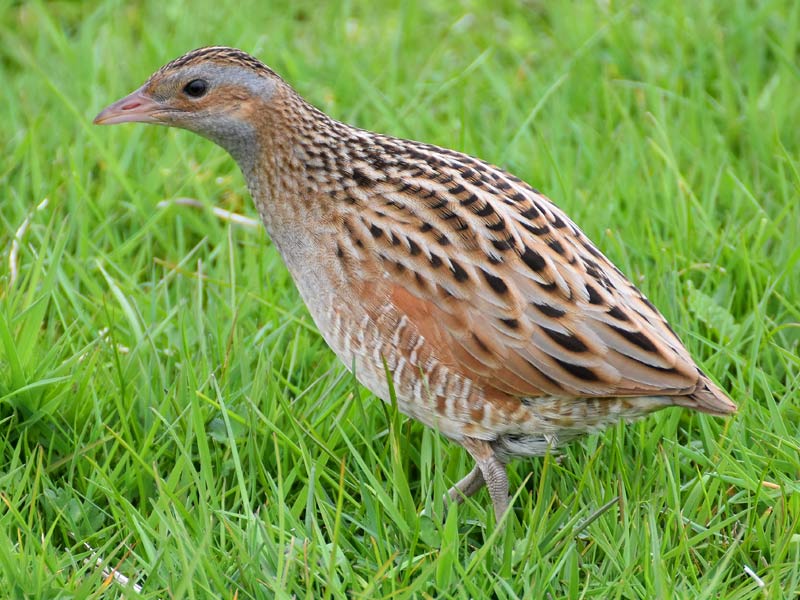A national survey of breeding Corncrakes in Ireland has revealed their numbers are at their highest for a decade.
Although numbers remain very low, a survey carried out by the National Parks and Wildlife Service (NPWS) has found 218 calling males – a 10% increase on 2022 numbers and a 35% increase over the past five years.
The positive trend in population numbers is the result of collaborative conservation measures involving local farmers and communities, the Corncrake LIFE Project, and the NPWS
The new figures show the Irish population has increased by as much as 82% since the lowest level of just 120 males was recorded in the early 1990s.
The NPWS said the birds have also expanded their range into new areas in counties Sligo and Kerry as well as areas outside the core Corncrake LIFE Project sites.

Corncrake, copyright Jim Swalwell, from the surfbirds galleries
Dr John Carey, of the Corncrake LIFE Project, said that if a person ever lived near corncrakes, they would know all about this bird because it is so loud.
“For many people growing up on farms and rural communities in the 1960s and the 1970s the corncrake was the sound of the summer and it has been lost.
“The population has declined by more than 90% since 1978. It fell as low as just 120 calling males at one point.”
There are several reasons for the drastic loss of suitable habitat behind the decline of corncrakes in Ireland but modern farming practices and mechanisation are at the heart of it.
Dr Carey points out that the map of where the corncrake population still survives here closely matches that of the Irish language and Gaeltacht regions.
“It is quite remarkable. Just like this bird, the Irish language was pushed out to the edge of the country too.
“In many ways, the corncrake is a bird of the Gaeltacht. You find it in Gaeltacht regions. These regions have climatic and geographic constraints which mean that farming hasn’t been intensified there. This is the real treasure of these areas.”
Now it is those same farming communities and their willingness to engage some traditional farming practices in the core breeding areas of counties Donegal, Mayo and Galway that is the key to the success of the Corncrake LIFE project.
As many as 250 farmers and landowners are managing close to 1,500 hectares of land for corncrakes.
They create large patches of nettles or crops on their holdings for the birds to hide in, and delay grass mowing until mid-August to enable them to raise broods of chicks in safety.
Studies show that mowing fields from the ‘centre–out’ rather than from the ‘outside- in’ can reduce chick mortality by up to 60%.
Agricultural contractors are key as they have the skills and knowledge to ensure that the birds are not harmed during harvesting time.
They are incentivised through targeted grants and Government schemes to protect the birds and give them a chance to rear their young.
At first glance the Corncrake LIFE Project may appear to focus on male birds because the males are counted first. But that is just because they are the ones that make all the noise.
When it comes to the actual conservation measures, however, the entire focus is on protecting the female bird with her nest and ten eggs, so that they can become adults and increase the population.
“We protect her by protecting her landscape. We know roughly where she will be,” Dr Carey said.
“We never find the nest because they are extremely difficult to find. We know that wherever the male is located from his calling position, the female is generally within 250 metres of him. So, we work with all the landowners within that buffer zone to try to protect as much land as we can from early mowing of the grass in the silage fields for as long as possible.
“Even if the farmers need to mow the grass, they make sure to mow those fields from the centre out rather than from the outside in. By doing that it drives the corncrakes out to the sides of the field and so reduces mortality.”
“We also work with farmers that don’t have the corncrake.
“We pay the farmers for producing habitat for the corncrake, not for having the bird itself. If we just react to where the birds are, then we will never see their range expanding.
“As the population increases in the core breeding areas the birds will naturally become a bit more nomadic and begin to spread out into the landscape.
“We have seen a population increase of 10% in 2023. So, there are more corncrakes in our landscape, and we need to create more space for them, work with more landowners, and try to put measures in place to protect those birds as the population increases”.
Responding to the survey findings, Minister for Heritage Malcolm Noonan said: “It’s fantastic to see that biodiversity action for the iconic corncrake is working.
“The increase from 161 to 218 birds in just five years is remarkable and a testament to the hard work and commitment of so many, not least the farmers and communities at the heart of the effort.
“This demonstrates that the collaborative approach being championed by the Corncrake LIFE team and the NPWS Corncrake Conservation Programme is not only effective but welcomed”.